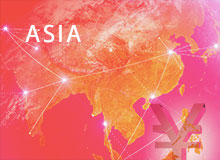“For China, the sky’s the limit …,” Apple CEO Tim Cook noted last year. “I’ve never seen so many people rise into the middle class who aspire to buy Apple products. It’s quickly become number two on our list of top revenue countries.”
Much has been written about the successes of foreign brands in China (e.g., KFC, GM, Starbucks, McDonald’s and Microsoft) as well as the failures (e.g., Yahoo, MySpace and eBay). But Apple’s success is unusual. Prior to 2008, the company had been quietly selling products in mainland China for more than a decade via its network of domestic specialty retailers. Compared to its business model in the U.S., where Apple’s company-owned stores are the centerpiece of its offline sales strategy, Apple effectively leveraged its network of third-party retailers to sell its products to Chinese consumers well before any Apple stores were opened there.
Although no one knows the exact number, analysts estimate that Apple’s network of authorized offline specialty retailers in China exceeds 2,000. These sites look and feel like traditional Apple stores but are clearly marked as “authorized resellers” and boast names such as “iSpace.” At the same time, the numerous unauthorized or illegitimate retailers throughout China can be difficult to distinguish from their authorized or legitimate counterparts. These unauthorized stores — which often sell authentic Apple products sourced domestically or abroad via opaque channels — copy the look and feel of real Apple outlets, including employee uniforms, outer glass walls and wooden display tables.
By mid-2008, according to research firm InStat, between 400,000 and 1,000,000 iPhones were in use in China. Sensing the potentially explosive market demand for iPhones there and recognizing the arbitrage opportunity, people used a variety of methods to purchase these Apple products in Hong Kong and the U.S. — where prices are roughly 30% cheaper than in mainland China — and smuggled them into China via unofficial gray channels. These devices were then often sold for a profit on websites such as Taobao, the eBay of China.
Prices of the newest iPhones can approach 200% of the price of mobile-carrier-subsidized iPhones in the U.S., due to the seemingly insatiable market demand and delayed Apple product releases in China relative to other markets. While these gray-market activities continue, the opening of multiple mainland China Apple stores, along with the requirement of mobile contracts to purchase iPhones at a discount in the U.S., have helped to combat this problem.
Apple Stores Go to China
In July 2008, just prior to the start of the Olympics, the first Apple store in China opened to great fanfare in Beijing’s Sanlitun Village. This was Apple’s 219th store globally. By the end of 2009, mainland China still remained a blip on Apple’s revenue radar. But over the next three years, the growth of Apple’s popularity and business in China soared as the company opened additional stores in Beijing and Shanghai. During the opening of the 16,000-square-foot store in Shanghai in 2010, Ron Johnson, then-senior vice president of retail operations, estimated that Apple would open 25 additional stores in mainland China over the next two years. By mid-2012, there were only six stores. The reasoning behind the slower-than-expected pace remains unclear, but most analysts attribute this delay to site-acquisition and general logistical challenges.
Nevertheless, the limited number of Apple stores in China has not hindered the company’s success there. According to Fortune magazine, Apple generates an average of US$4,032 in revenue per square foot per year in its stores globally, a number that would make any retailer jealous. In comparison, luxury jeweler Tiffany and consumer-electronics giant Best Buy generate US$2,666 and US$930 in revenue per square foot per year, respectively, in their company-owned stores. Apple’s mainland China stores are said to be among the company’s highest-trafficked and most profitable stores globally.
According to Alvin Tse, product director at Flipboard China, a popular iOS application developer, there were 20 million to 30 million iPhone activations in mainland China at the end of 2011. He estimated that there will likely be a similar number of additional activations in 2012. These numbers include devices purchased both within and outside China.
According to Apple’s second quarter 2012 analyst earnings call, the company generated US$7.9 billion in revenue in China, up 300% compared to the same period in 2011. iPhone sales were up 500% from a year earlier. China accounted for 20% of Apple’s total second-quarter revenue, up from 2% during the same period in 2009, despite just six Greater China retail stores. To put this in context, Reuters noted that Pennsylvania has eight Apple stores amid a population of nearly 13 million. Given there is currently only one Apple store for every 216 million people in China, it is no surprise that Apple’s Cook sees China as a massive future-growth opportunity for the company in China.
On the third quarter 2012 earnings call, Cook stated that Apple’s revenue in China was US$5.7 billion for the quarter, an increase of 48% compared to the same period the year before. Through three quarters in 2012, the company’s revenues in China totaled US$12.4 billion, compared to US$13.3 billion for all of 2011. Apple’s successful launches of the iPhone 4S and the new iPad — coupled with the recent addition of China Telecom and the potential near-term addition of China Mobile (and its more than 600 million mobile subscribers) to its list of domestic Chinese mobile-carrier partners — are clear indications that the company shows no signs of slowing down in China.
In comparison, KFC and Starbucks are often highlighted as examples of successful foreign companies in China. According to KFC parent company YUM! Brands’ 2011 annual report, at the end of 2011, KFC had more than 3,700 restaurants in over 700 cities across China. The report went on to note that China accounted for 44%, or US$5.5 billion, of YUM’s US$12.6 billion global revenue in 2011. As of early 2012, Starbucks had more than 550 locations in China, and mainland China accounted for 5% of the company’s revenues. In the quarter ending in April 2012, KFC and Starbucks generated revenues of US$1.2 billion and US$176 million, respectively, in mainland China, compared to Apple’s US$7.9 billion in revenue during the same period.
Status and Independence …
Apple devices are considered luxury products in China. According to the 2011 McKinsey Insights China report on “Understanding China’s Love for Luxury,” the luxury market in China is projected to hit US$27 billion by 2015, accounting for more than 20% of the global luxury market. Apple’s iPhone 4 retails for 6,000 RMB (~US$945) in mainland China, which equates to roughly 25% to 30% of the average annual income in China.
Luxury, social status and standing out from the crowd often go hand in hand. In China, this relationship is accentuated by an innate Chinese cultural mindset known as mian zi, or “face.” One’s “face” implies one’s reputation, honor and, to a certain extent, social standing. In a market with more than one billion mobile subscribers, a mobile device is, in some ways, the ubiquitous representation of status in China.
In the U.S., Apple’s “Think Different” campaign successfully targeted consumers who classified themselves as innovators, creative thinkers and bold pioneers outside the mainstream. While few people in China actually understood this philosophy, they did know that the iPhone is not only a luxury that not everyone can afford; it is also the embodiment of what Hannah Beech referred to in her Time magazine article, “The Cult of Apple in China,” as “individualistic western” culture, which allows Chinese iPhone owners to differentiate themselves from the masses. According to Mickey Du, an investment professional at Innovation Works — a seed-stage investment fund, founded by former Microsoft and Google China head Kai-Fu Lee, that focuses heavily on the mobile market in China — the iPhone is the ultimate expression of a smartphone in China. It should come as no surprise that the iPhone is approaching double-digit smartphone market share in Tier 1 cities such as Shanghai, which, according to McKinsey, accounts for 21% of China’s luxury market.
Chris Evdemon, a partner at the Innovation Works Development Fund, is quick to point out that Apple products are still mainly about status in China. He notes that the extent to which status plays a role in buying decisions for Chinese consumers depends on which segment of the Chinese market one is talking about. The average smartphone user in China is 22 to 24 years of age, compared with 35 to 40 years of age in the U.S. Whereas smartphone usage in the U.S. tends to be driven by work and utility, usage in China is centered more around entertainment and gaming. Evdemon points out that Chinese consumers use only about 20% of the iPhone’s functionality capabilities, which is further evidence that status is a major driving force behind Chinese consumer buying decisions when it comes to smartphones.
… But Also Functionality, Personalized Experience and Localization
According to the 2011 Annual Chinese Consumer Study report conducted by McKinsey, basic functional requirements, such as product durability for consumer electronics, still determine consumers’ choice of brand. A challenge that all luxury companies face in China is the abundance of knock-off products and unauthorized dealers. However, unlike a knock-off Louis Vuitton purse, which could serve the same basic functions as an authentic LV bag, the combination of the iPhone’s vast selection of apps from the App Store, music selections from iTunes, sophisticated software capabilities and seamlessly integrated hardware and software user experiences cannot be easily replicated by knock-off products.
In addition, better-informed consumers and greater exposure to real luxury products, via media channels such as the Internet, increase the likelihood of being caught with a fake Apple product, thus deterring many Chinese shoppers from considering a knock-off product as a way to establish status. According to the 2011 McKinsey Insights China report, the percentage of consumers who said they were willing to buy fake jewelry dropped significantly, from 31% in 2008 to 12% in 2011. This general consumer trend toward authentic products as a way of enhancing social status and gaining access to superior functionality and design elements will continue to benefit Apple going forward.
Chinese consumers today are looking for more than just luxury goods; they want the luxury experience as well. According to BCG’s 2012 report, “Luxe Redux: Raising the Bar of the Selling of Luxuries,” sales for personal luxury goods increased 22% annually, while experiential luxury grew by 28%. In a market where consumers love to touch and feel before they buy, Apple has turned the retail shopping experience into entertainment.
Conventional wisdom suggests that product and market localization should be the centerpiece of any company’s entry strategy into China. The popularity of Starbucks’ green-tea frappuccinos and KFC’s egg tarts at their mainland China locations are evidence that product localization works. However, true to its “Think Different” company DNA, Apple seems to have done just fine to date with little-to-no product or market localization in China. The company is only now starting to experiment with the integration of Chinese search engine Baidu, online video site Youku and popular social-networking tool Sina Weibo (the “Twitter of China”) in the latest version of the Mac iOS.
According to Flipboard’s Tse, the launch of local lower-cost competitors might lead to continued measured localization of Apple products in China. As an example, local upstart Xiaomi, which was founded by Chinese entrepreneur and noted angel investor Lei Jun, sells integrated hardware and software handsets for 2,000 RMB (~US$318) in China, roughly 50% of the cost of an iPhone. Xiaomi recently completed raising capital at a US$4 billion valuation and already has orders for millions of its smartphones in China. Despite the firm’s lower price point and early traction, Tse is quick to point out that Xiaomi phones feel like tools to Chinese consumers, whereas iPhones are emotional experiences. Apple’s success in China suggests that the company’s uncanny ability to connect with its consumers on an emotional level is universal, transcending borders, languages and cultures.
Combination of Product and Market Fit
Apple has been a success story in China to date and is the envy of many other foreign companies that have yet to crack the Chinese consumer code. In some ways, Apple in China is the perfect combination of product and market fit. The company’s meteoric rise in that country suggests that Chinese consumers are slowly evolving from merely making buying decisions based on status toward demanding products that also offer superior design and functionality.
Apple products appeal fundamentally to the Chinese notion of “face” and the desire for differentiation from the crowd, while also catering to increasingly important aspects of Chinese consumer behavior, including functionality, personalized buying experiences and localization. Although iPhone activations in China currently lag behind Android activations by a ratio of 4:1 (i.e., Android, 80 million; Apple, 20 million to 30 million), a gap that is widely expected to increase over time, McKinsey notes that the number of upper-middle-class households in China earning 94,500-189,000 RMD (~US$15,000-US$30,000) annually is expected to reach 76 million by 2015, which should translate into continued success for Apple in China for the foreseeable future.
This article was written by David Cummins, Sydney Liu and Alice Yeh, members of the Lauder Class of 2014.



